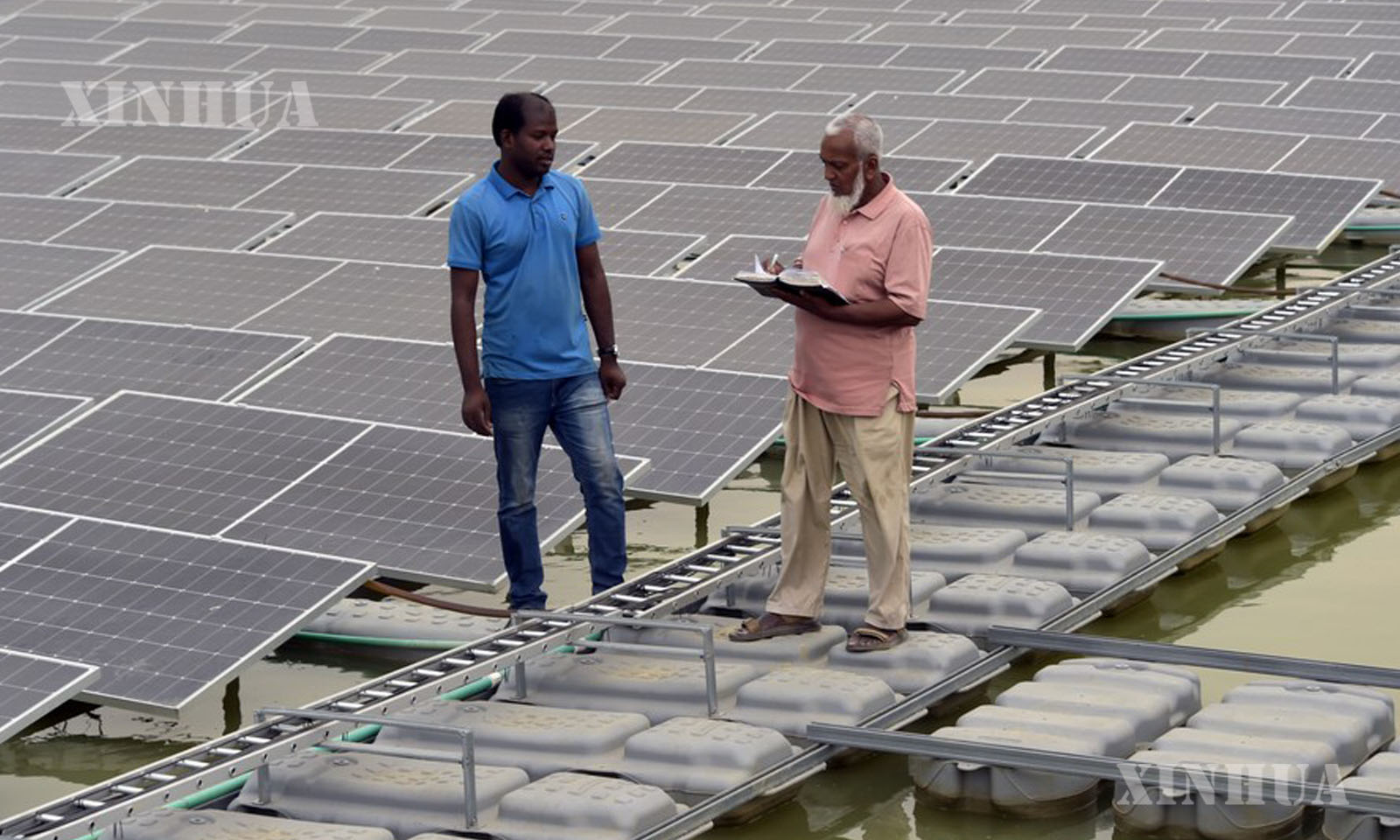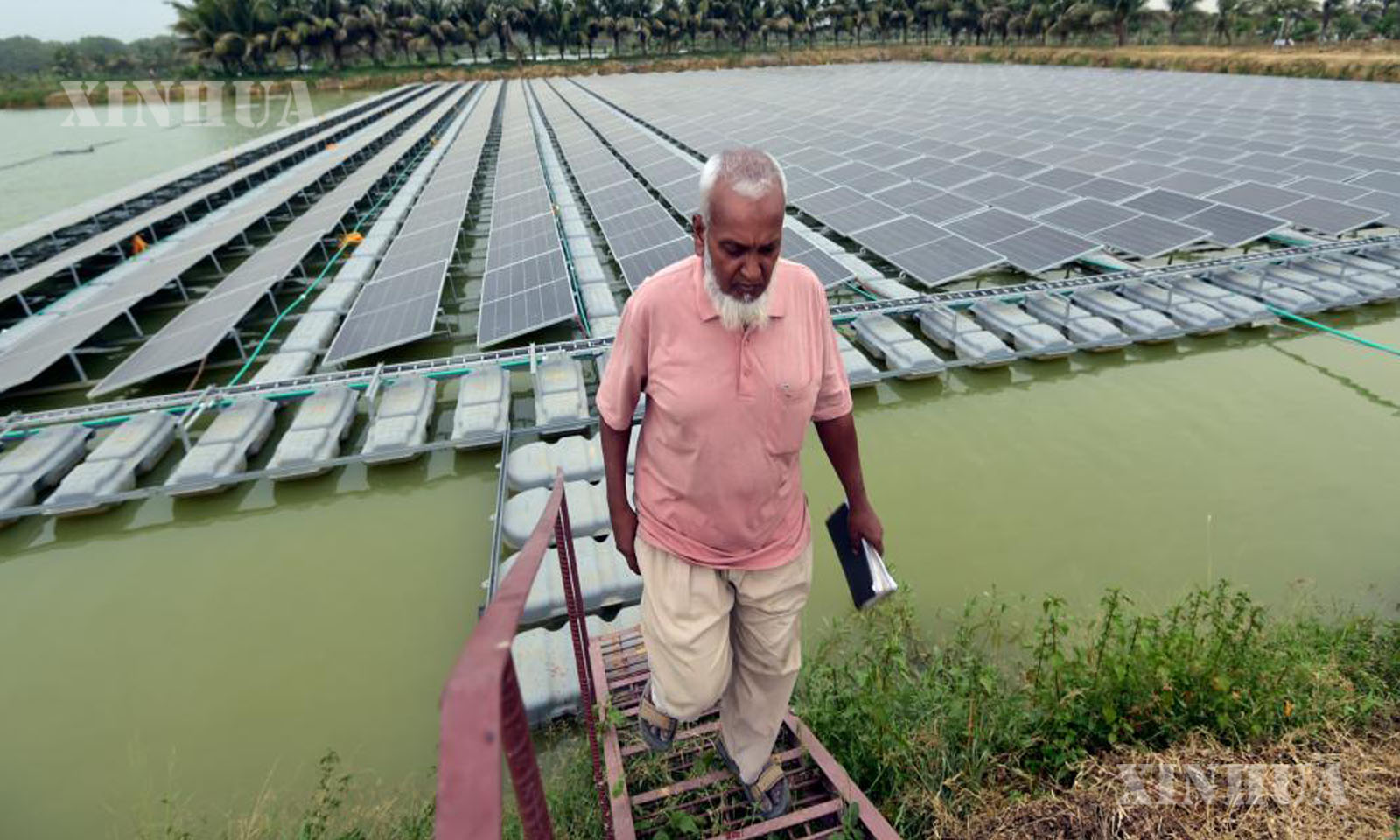Asia
ဘင်္ဂလားဒေ့ရှ်နိုင်ငံ၏ အကြီးဆုံး “ဆိုလာ ငါးမွေးမြူရေးလုပ်ငန်း” က သီးနှံကြိတ်ခွဲစက်နှင့် အမျိုးသားဓာတ်အားလိုင်းကို လျှပ်စစ်ဓာတ်အား ပံ့ပိုးပေးလျက်ရှိ

Chapainawabganj ၊ ဘင်္ဂလားဒေ့ရှ်၊ ဇွန် ၁၅ ရက် (ဆင်ဟွာ)
နေရောင်ခြည်များက ထောင်ပေါင်းများစွာသော ရေပေါ်ဆိုလာပြားများပေါ်သို့ ကျရောက်လာချိန်တွင် ဘင်္ဂလားဒေ့ရှ်ရှိ ဒေသခံစက်ရုံနှင့် အမျိုးသားလျှပ်စစ်ဓာတ်အားပေးကွန်ရက်က ငါးမွေးမြူရေးရေကာတာမှ ထုတ်လုပ်သော လျှပ်စစ်ဓာတ်အားကို အသုံးပြုလျက်ရှိကြောင်း သိရသည်။

ဘင်္ဂလားဒေ့ရှ်နိုင်ငံ Chapainawabganj ခရိုင်ရှိ ရေကာတာများပေါ်တွင် တပ်ဆင်ထားသော ရေပေါ်ဆိုလာပြားများကို စစ်ဆေးနေသည့် နည်းပညာရှင်များအား ၂၀၂၃ ခုနှစ် ဇွန် ၅ ရက်က တွေ့ရစဉ် (ဆင်ဟွာ)

ဘင်္ဂလားဒေ့ရှ်နိုင်ငံ Chapainawabganj ခရိုင်ရှိ ရေကာတာများပေါ်တွင် တပ်ဆင်ထားသော ရေပေါ်ဆိုလာပြားများကို စစ်ဆေးနေသည့် နည်းပညာရှင်တစ်ဦးအား ၂၀၂၃ ခုနှစ် ဇွန် ၅ ရက်က တွေ့ရစဉ် (ဆင်ဟွာ)
အစားအစာနှင့် လျှပ်စစ်စွမ်းအင်ထုတ်လုပ်မှု ပေါင်းစပ်ထားသော အကောင်းဆုံးဥပမာတစ်ခုဖြစ်သည့် Joules Nawab ရေပေါ်စွမ်းအင်စက်ရုံစီမံကိန်းတွင် လူကဖန်တီးပြုလုပ်ထားသော ဧရိယာ စတုရန်းမီတာ ၂၂,၀၀၀ ရှိ ရေကန်အတွင်း ရေပေါ်ပလက်ဖောင်းများပေါ်၌ ဆိုလာပြား အမြောက်အမြားကို တပ်ဆင်ထားခြင်းဖြစ်သည်။
ရေပေါ်ဆိုလာပြားများကို အသုံးပြု၍ သန့်စင်သောလျှပ်စစ်ဓာတ်အားထုတ်လုပ်မှုသည် ယခင်က ငါးမွေးမြူရေးလုပ်ငန်းတစ်ခုတည်းအတွက်သာ အသုံးပြုခဲ့ခြင်းဖြစ်သည်။ လျှပ်စစ်ဓာတ်အားထုတ်လုပ်မှုကြောင့် ငါးမွေးမြူရေးလုပ်ငန်းကို ထိခိုက်ခြင်းမရှိသလို ဘင်္ဂလားဒေ့ရှ်နိုင်ငံ၏ စဉ်ဆက်မပြတ် ဖွံ့ဖြိုးတိုးတက်မှု ပန်းတိုင်များနှင့် ကိုက်ညီမှုရှိစေရေး၊ ရာသီဥတုပြောင်းလဲမှု တိုက်ဖျက်ရေး ကြိုးပမ်းအားထုတ်မှုများအား ပံ့ပိုးကူညီပေးနိုင်မည်ဖြစ်ကြောင်း သိရသည်။
ဘင်္ဂလားဒေ့ရှ်နိုင်ငံ၏ ဆိုလာစွမ်းအင်ထုတ်လုပ်မှု တိုးချဲ့ရေး အဓိကဆောင်ရွက်မှုဖြစ်သော ပထမဆုံး စီးပွားရေးလုပ်ငန်းသုံး ရေပေါ်ဆိုလာစွမ်းအင်စက်ရုံသည် မြို့တော် ဒါကာမှ အနောက်မြောက်ဘက် ၃၀၂ ကီလိုမီတာခန့်အကွာ Chapainawabganj ခရိုင်၌ တည်ရှိပြီး မကြာသေးမီက အမျိုးသားဓာတ်အားလိုင်းနှင့် ချိတ်ဆက်ခဲ့သည်။
အဆိုပါ စီမံကိန်းသည် လျှပ်စစ်ဓာတ်အား မဂ္ဂါဝပ် ၂.၃၀ ထုတ်လုပ်နိုင်စွမ်းရှိပြီး ရင်းနှီးမြှုပ်နှံမှုအနေဖြင့် အမေရိကန်ဒေါ်လာ ၁.၅ သန်းခန့်လိုအပ်ကြောင်း၊ ယင်းစီမံကိန်းတွင် တရုတ်နှင့် ဂျာမနီ ကုမ္ပဏီများမှ ရေပေါ်ဖော့ပြားများ၊ ဆိုလာပြားများနှင့် အင်ဗာတာများ အသုံးပြုထားကြောင်း သိရသည်။ (Xinhua)
………………………………
(English Version)
Bangladesh’s largest “solar fish farm” powers mill, national grid
CHAPAINAWABGANJ, Bangladesh, June 15 (Xinhua) — As the sun beams down on the thousands of floating solar panels, electricity is generated for a local mill and the national grid at a reservoir also used for fish farming in Bangladesh.
In a classic example of the food-energy nexus, the Joules Nawab Floating solar plant project consists of numerous solar panels mounted on specially designed floating platforms in a human-made pond spanning an area of 22,000 square meters.
The production of clean energy using floating solar panels, utilizes an expanse of water previously used for fish farming only. The electricity is produced without hampering the farming of fish and will contribute to the country’s efforts to meet its sustainable development goals and combat climate change.
In a major step towards expanding the country’s solar energy production, Bangladesh’s first floating commercial solar power plant, located in Chapainawabganj district, some 302 km northwest of the capital Dhaka, was connected to the national grid recently.
The project has a production capacity of 2.30 megawatts and required an investment of around 1.5 million U.S. dollars. It uses floaters, solar panels and inverters from Chinese and German firms.
Photo 1: Photo taken on June 5, 2023 shows floating solar panels installed on reservoirs in Chapainawabganj, Bangladesh. (Xinhua)
Photo 2: Technicians inspect floating solar panels installed on reservoirs in Chapainawabganj, Bangladesh, June 5, 2023. (Xinhua)
Photo 3: A technician inspects floating solar panels installed on reservoirs in Chapainawabganj, Bangladesh, June 5, 2023. (Xinhua)






